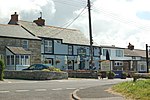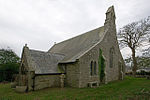Tregonning Hill
Cornish KillasGeology of CornwallHills of CornwallSites of Special Scientific Interest in CornwallSites of Special Scientific Interest notified in 1994

Tregonning Hill is the westerly of two granite hills overlooking Mount's Bay in west Cornwall, United Kingdom, the other being Godolphin Hill. They are approximately 6 kilometres (3.7 mi) west of the town of Helston. The Plymouth chemist William Cookworthy mixed china stone with kaolin, mined from the hill to make Plymouth porcelain in 1768; which was the first time hard-paste porcelain was made in Britain. Part of the hill is designated as a Site of Special Scientific Interest (SSSI) and at the date of notification (1994) was the only known site of western rustwort (Marsupella profunda) in Great Britain.
Excerpt from the Wikipedia article Tregonning Hill (License: CC BY-SA 3.0, Authors, Images).Tregonning Hill
Herland Park,
Geographical coordinates (GPS) Address Nearby Places Show on map
Geographical coordinates (GPS)
| Latitude | Longitude |
|---|---|
| N 50.1184 ° | E -5.3551 ° |
Address
Herland Park
TR13 9RJ
England, United Kingdom
Open on Google Maps








